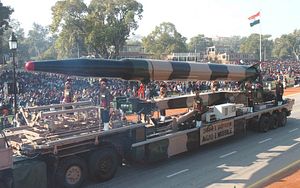India’s Strategic Forces Command (SFC) test fired an Agni-I short-range nuclear capable ballistic missile from the Integrated Test Range (ITR) at the Dr Abdul Kalam Island in the Bay of Bengal off the coast of Odisha on February 6.
The launch was part of the SFCs annual training cycle to test the operational readiness of India’s missile force. The Agni-I was fired at 8:30 a.m. local time from a transporter erector launcher. According to defense sources speaking to local media, the launch was “a complete success” as all main test objectives were met.
“The trajectory of the trial was tracked by a battery of sophisticated radars, telemetry observation stations, electro-optic instruments and naval ships right from its launch till the missile hit the target area with pin point accuracy,” sources said. The Agni-I, fitted with an accurate inertial navigation system, was last successfully test fired on November 22, 2017.
The single-state, solid fuel missile, developed by India’s Defense Research and Development Organization (DRDO), was first introduced into service in 2004. It has an operational range of 700-900 kilometers and can alternatively be armed with a 1,000-kilogram conventional or nuclear warhead.
The SFC currently fields around 75 Agni-I launchers, although the number of operational missiles is likely to be higher.
The missile is part of India’s credible minimum deterrence doctrine and has been developed to offset Pakistan’s burgeoning nuclear missile arsenal. India has a No First-Use (NFU) policy and keeps its nuclear warheads de-mated from the actual missiles. India is estimated to possess 120-130 nuclear warheads.
Last month, Indiasuccessfully test fired its most advanced nuclear-capable intercontinental ballistic missile (ICBM), the Agni-V. As I reported:
The Agni-V, a three-stage solid fueled missile, has an approximate range of 5,500-5,800 kilometers [the exact range remains classified], and can carry a 1,500-kilogram (3,300-pound) nuclear warhead. India has reportedly also been working on multiple independently targetable reentry vehicles (MIRV) for the Agni-V in order to ensure a credible second-strike capability.
The missile is designed to provide a credible nuclear deterrent against China.
India has also made progress on establishing the the sea leg of its strategic deterrent triad. In December 2017, the second Arihant-class nuclear-powered ballistic missile submarine (SSBN), the future INS Arighant, was launched. The new SSBN will be able to carry up to eight K-4 missiles, an intermediate-range nuclear-capable submarine-launched ballistic missile (SLBM).
The first-of-class INS Arihant spent ten months out of action last year due a hatch mistakenly left sealed near the rear of the hull, which allowed salt water to enter the subs’ nuclear propulsion compartment.
(My colleagues Ankit Panda and Prashanth Parameswaran discussed recent developments with India’s nuclear forces in a podcast.)

































